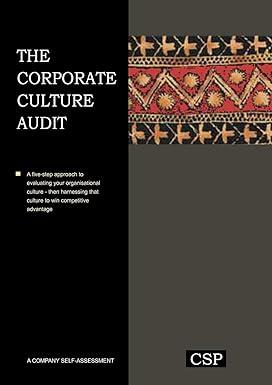Question
Gardner Widgets Inc. (GWI) develops and manufactures widgets that are used in high-tech manufacturing processes. The company was formed by five investors who started the
Gardner Widgets Inc. (GWI) develops and manufactures widgets that are used in high-tech manufacturing processes. The company was formed by five investors who started the company in 2005. The company has been very successful. In the last couple of years, some of the owners grew tired of being involved with GWI and the other owners didnt want to continue if all the investors werent involved, so the investors tried to find a buyer for GWI. The investors were surprised to find that it wasnt easy for them to find someone to buy the company, despite GWIs success. Finally, they found an interested buyer in Mega Enterprises Ltd. (MEL), a publicly-traded Canadian company. Negotiations were tough and the parties werent able to agree on a firm price. In the end, they agreed that MEL would pay $15 million in cash plus four times audited income before taxes for the year ended December 31, 2020, applying IFRS on a consistent basis and including only normal operating items. (Before the sale GWI was using ASPE but the switch to IFRS was necessary because MEL is a public company.) The average net income for the years 2016 through 2019 was $5.4 million. The sale closed on June 7, 2020. The five investors received the initial $15 million payment on that day.
On February 19, 2021, two of the original GWI investors met with your firm. They were not happy. They had received the day before by courier the financial statements for GWI for the year ended December 31, 2020, along with a cheque for $14.4 million (four times the 2020 net income of $3.6 million). The amount came as a big shock to the investors. They were expecting over $20 million because at the time the deal closed they thought GWI was performing as well as in recent years. As part of the agreement of purchase and sale, the investors accountants are allowed to review the auditors working papers* pertaining to the GWI audit, which was conducted by MELs auditor. *Audit working papers document the information gathered during an audit by the auditor to support the auditors opinion.
Since the meeting, your firms staff has reviewed the auditors working papers and have identified a number of areas of concern. The partner has asked you, a CPA with the firm, to address some of the issues identified. The partner would like you to analyze the issues and write a memo to him addressing them. The partner provided you with a summary of the issues he wants you to address:
a) In its review of the working papers your firms audit staff noted an unusual revenue transaction. In August 2020 GWI received a $2 million non-cancellable order from one of its established customers. The order cant be cancelled because these widgets would have only been useful to this customer. The order was for a specially designed widget the customer needs for a new product. The customer asked for delivery only when the order was fully completed because of special storage requirements for the widgets. GWI completed production of the widgets in mid-December and they were ready to ship a few days after that. Because of logistic problems the widgets were shipped to the customer in early January. GWI recognized the revenue on delivery, as is its normal practice. GWI incurred $250,000 in development costs for the order. The design is currently only applicable to this customers widget but GWI expects that it will have applications for widgets GWI will develop and sell in the future. These development costs were expensed as incurred. The cost of producing the widgets was $347,000.
b). During the third quarter, three senior managers were fired. As part of the settlement package, GWI agreed to continue paying the employees' salaries for one year from the date of dismissal. Each of the managers had salaries of $200,000 per year and as of December 31, 2020, they will continue to draw salaries for 10 months. GWI expensed the $600,000 in salaries that would be paid at the time the settlement was signed by the parties.
c). In November 2020 GWI purchased a piece of used equipment at an auction for $3.7 million. The equipment was less than a year old and in almost new condition. GWI incurred $250,000 in transportation and installation costs, which were expensed as incurred. After installation $700,000 of work was needed to modify the equipment to meet GWIs requirements and to upgrade some of the parts. The $700,000 was expensed as maintenance expenses. The company decided to use an accelerated depreciation method of 30% per year declining balance, which is the rate required for such assets for income tax purposes and expensed a full year of depreciation. GWI uses straight-line depreciation for most of its other equipment.
d). In December, accountants from MELs head office analyzed GWIs accounts receivable. Based on that analysis MELs CFO told GWI that estimated bad debts should be calculated on the assumption that any receivables over 60 days old wont be collected. MELs CFO wrote in a memo that the company wants to be more conservative in its accounting so as to build confidence with MELs shareholders. Historically, GWI didnt do a great job collecting its receivables but it eventually collected 75% of receivables more than 60 days old. As a result of this change, the bad debt expense for 2020 increased by $75,000.
Step by Step Solution
There are 3 Steps involved in it
Step: 1

Get Instant Access to Expert-Tailored Solutions
See step-by-step solutions with expert insights and AI powered tools for academic success
Step: 2

Step: 3

Ace Your Homework with AI
Get the answers you need in no time with our AI-driven, step-by-step assistance
Get Started


